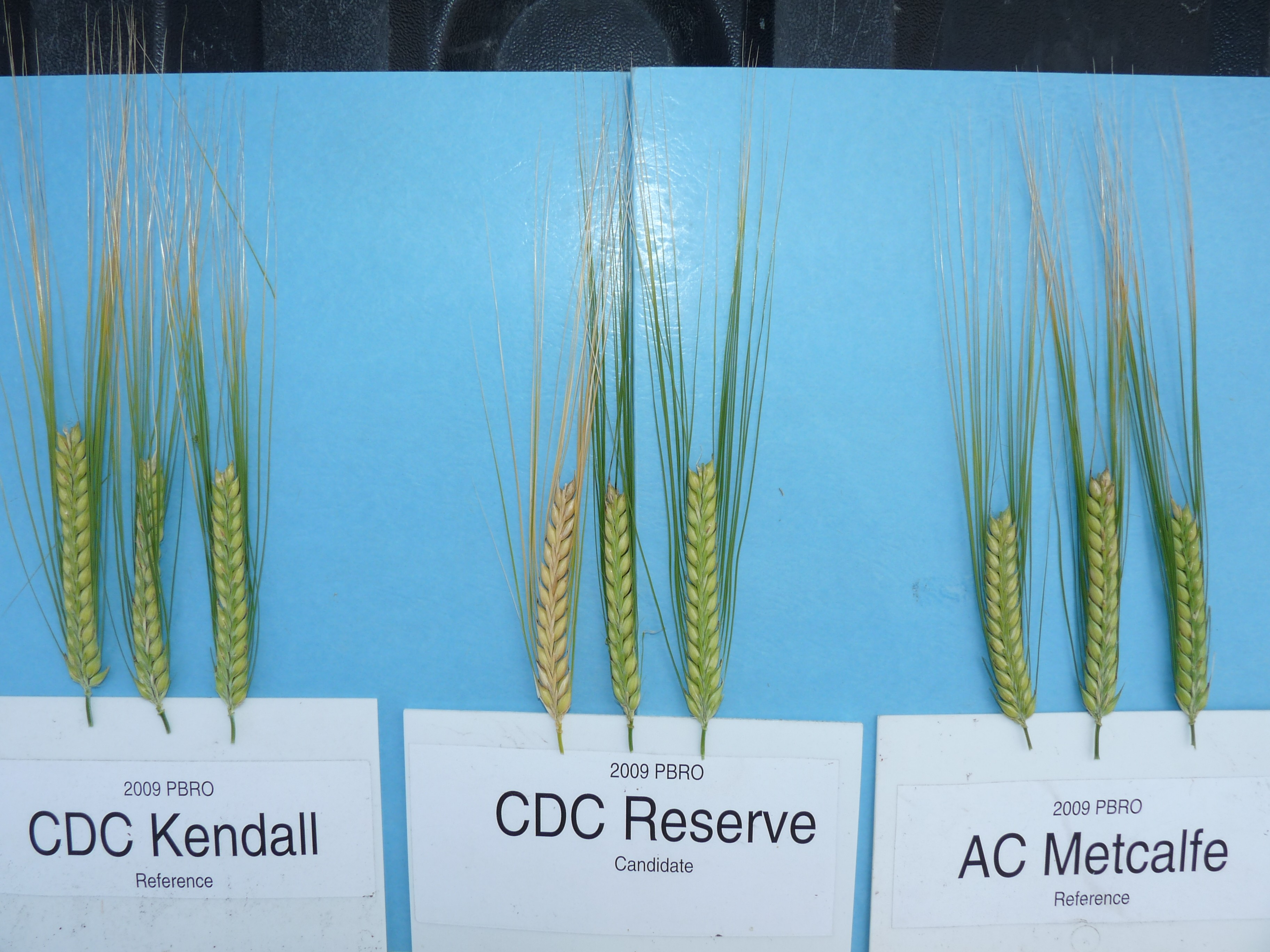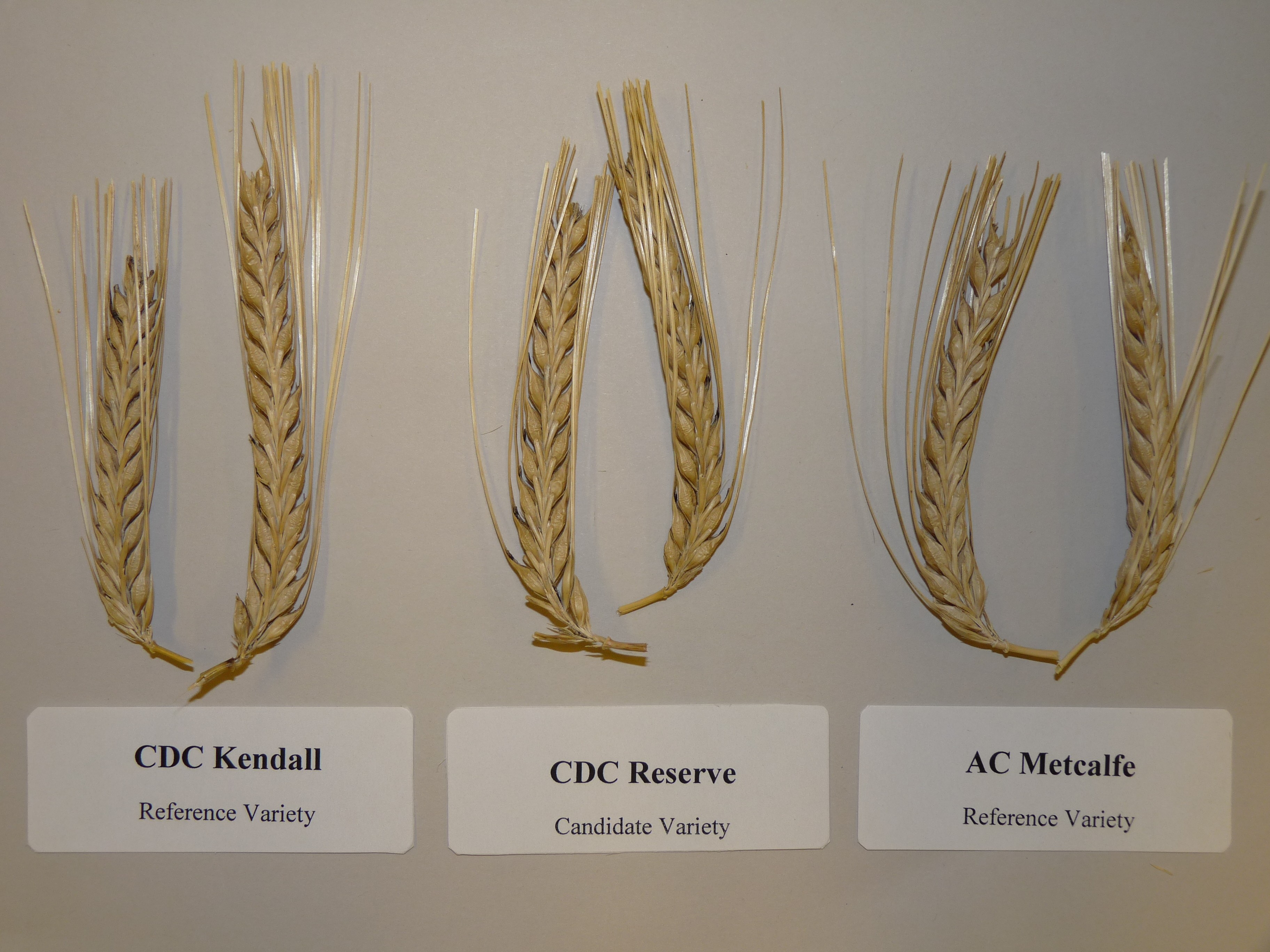CDC Reserve
| Denomination: | 'CDC Reserve' |
|---|---|
| Previously Proposed Denomination: | 'TR05912' |
| Botanical Name: | Hordeum vulgare |
| Applicant/Holder: |
University of Saskatchewan Crop Development Centre 4D36 Agriculture Building, 51 Campus Drive Saskatoon, Saskatchewan S7N 5A8 Canada |
| Breeder: |
Brian Rossnagel, University of Saskatchewan, Saskatoon, Saskatchewan |
| Agent in Canada: |
SeCan Association 400-300 Terry Fox Drive Kanata, Ontario K2K 0E3 Canada Tel: 613-592-8600 ext.223 |
| Application Date: | 2008-04-17(priority claimed) |
| Application Number: | 08-6295 |
| Protective direction granted: | 2008-04-17 |
| Protective direction withdrawn: | 2008-05-07 |
| Grant of Rights Date: | 2010-09-13 |
| Certificate Number: | 3943 |
| Date rights revoked: | 2016-09-13 |
Variety Description
Varieties used for comparison: 'CDC Kendall' and 'AC Metcalfe'
Summary: 'CDC Reserve' has a higher frequency of plants with recurved flag leaves than either 'CDC Kendall' or 'AC Metcalfe'. The auricles of the flag leaves of 'CDC Reserve' have a strong intensity of anthocyanin colouration while it is medium in 'AC Metcalfe'. 'CDC Reserve' has medium pubescence on the flag leaf while it is strong in 'AC Metcalfe'. The tips of the lemma awns of 'CDC Reserve' have a strong intensity of anthocyanin colouration while it is medium in 'AC Metcalfe'. 'CDC Reserve' has weak to medium anthocyanin colouration of the nerves of the lemma of the kernel while it is very weak to weak in 'CDC Kendall'.
Description:
PLANT: two row, spring malting barley, semi-erect to intermediate juvenile growth habit, very sparse to sparse pubescence on the sheaths of the lower leaves
FLAG LEAF: medium to high frequency of plants with recurved flag leafs, medium pubescence on blade
FLAG LEAF SHEATH: strong glaucosity, sparse pubescence
AURICLES: strong anthocyanin colouration, very sparse to sparse pubescence on the margins
SPIKE: mid-season to late spike emergence, v-shaped to cup shaped collar, strong intensity of anthocyanin colouration of the tips of the lemma awns, semi-erect attitude, strong glaucosity, parallel shape, dense density, divergent attitude of sterile spikelet, the length of the glume and its awn of the median spikelet is mainly equal relative to the grain
FIRST SEGMENT OF RACHIS: short to medium length, medium curvature
LEMMA AWNS: longer relative to the spike, rough spiculations from the tip to next to the kernel
KERNEL: weak to medium anthocyanin colouration of nerves of the lemma at beginning of ripening, whitish aleurone layer, husk present, long rachilla hair, medium to strong spiculation of inner lateral nerves of dorsal side of lemma, no hairiness on ventral furrow, clasping disposition of lodicules, horseshoe to incomplete horseshoe shape of basal markings, medium to long length, medium to wide width
DISEASE REACTION: very susceptible to True Loose Smut (Ustilago nuda), Stem Rust (Puccinia graminis), Septoria Speckled Leaf Blotch (Septoria passerinii), and Scald (Rhynchosporium secalis), susceptible to Fusarium Head Blight (Fusarium graminearum; perfect state Gibberella zeae), Covered Smut (Ustilago hordei), False Loose Smut, Black Semi-Loose Smut (Ustilago nigra), Spot Blotch (Cochliobolus sativus) and Net Blotch (Pyrenophora teres), moderately susceptible to Common Root Rot (Cochliobolus sativus, Fusarium spp.)
AGRONOMY: fair to good resistance to lodging, good resistance to shattering, good tolerance to straw breakage, fair to good tolerance to drought, good malting quality
Origin & Breeding History: 'CDC Reserve' (experimental designations 'SM03374s' and TR05912) was developed by the Sapporo Breweries/ Crop Development Centre/ Prairie Malt Ltd. collaboration barley breeding program using a pedigree breeding system. It originates from the cross TR253 / H96034 // CDC Kendall made at Sapporo Breweries Ltd., Gumma, Japan in 1998. The F1 thru F5 generations were grown as bulk populations with the F1 and F2 grown in nurseries in Japan, the F3 grown in Saskatoon, Saskatchewan and the F4 grown in winter nurseries in New Zealand. 'CDC Reserve' was grown and selected as a single F5 derived F6 row plot at Saskatoon in 2002. The seed of that F6 row plot was bulked as the line 'SM03374s'. It was tested in Crop Development Centre yield trials in 2003 and 2004, followed by further testing in the Western Canadian Two-row Cooperative Trials as 'TR05912' during 2005 and 2006. Selection criteria included high yield potential, early to moderate maturity, grain quality including test weight, kernel weight and kernel plumpness and malt quality including water sensitivity.
Tests & Trials: Tests and trials were conducted during the summers of 2008 and 2009 at the University of Saskatchewan, Saskatoon, Saskatchewan. Plots consisted of 5 rows with a row spacing of 0.2 meters and a row length of 3.66 meters. There were 2 replicates arranged in a RCB Design. Measured characteristics were based on a minimum of 20 measurements per variety per year.
Click on image for larger view

Barley: 'CDC Reserve' (centre) with reference varieties 'CDC Kendall' (left) and 'AC Metcalfe' (right)
Click on image for larger view

Barley: 'CDC Reserve' (centre) with reference varieties 'CDC Kendall' (left) and 'AC Metcalfe' (right)
- Date modified: